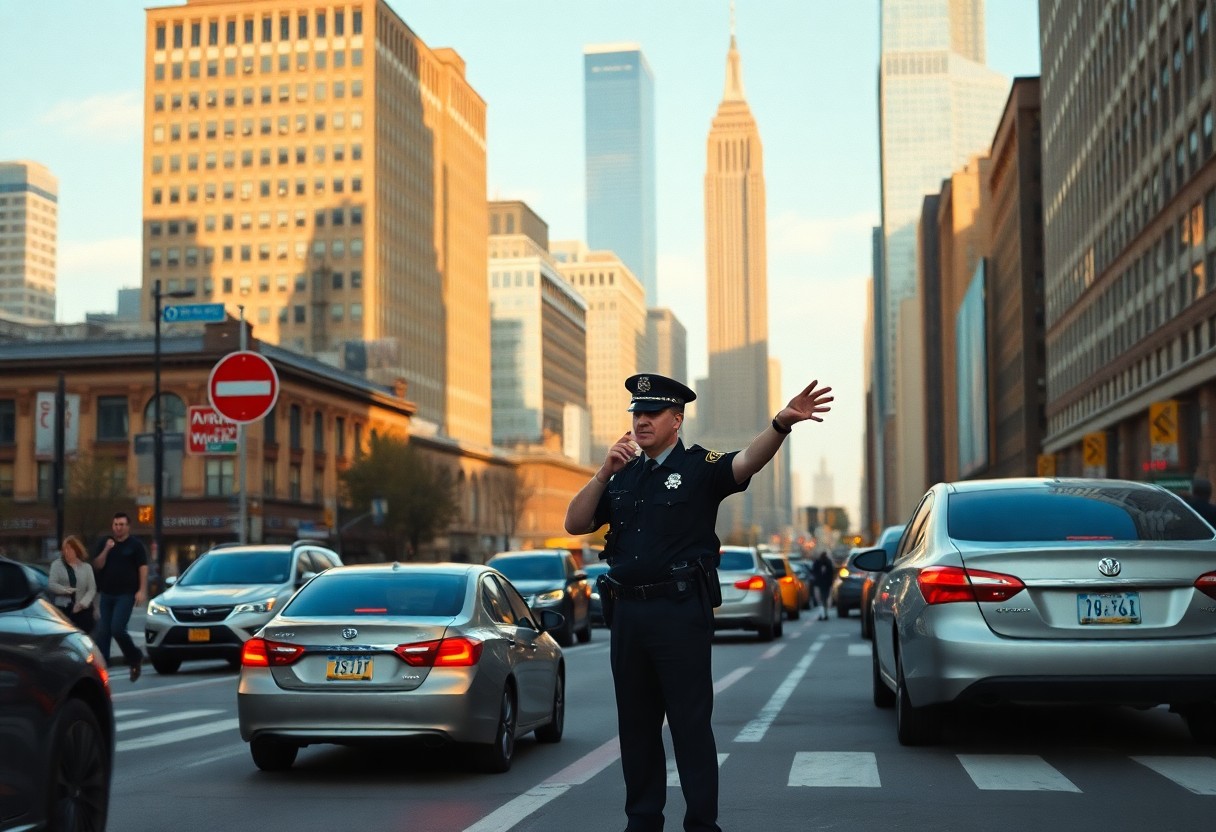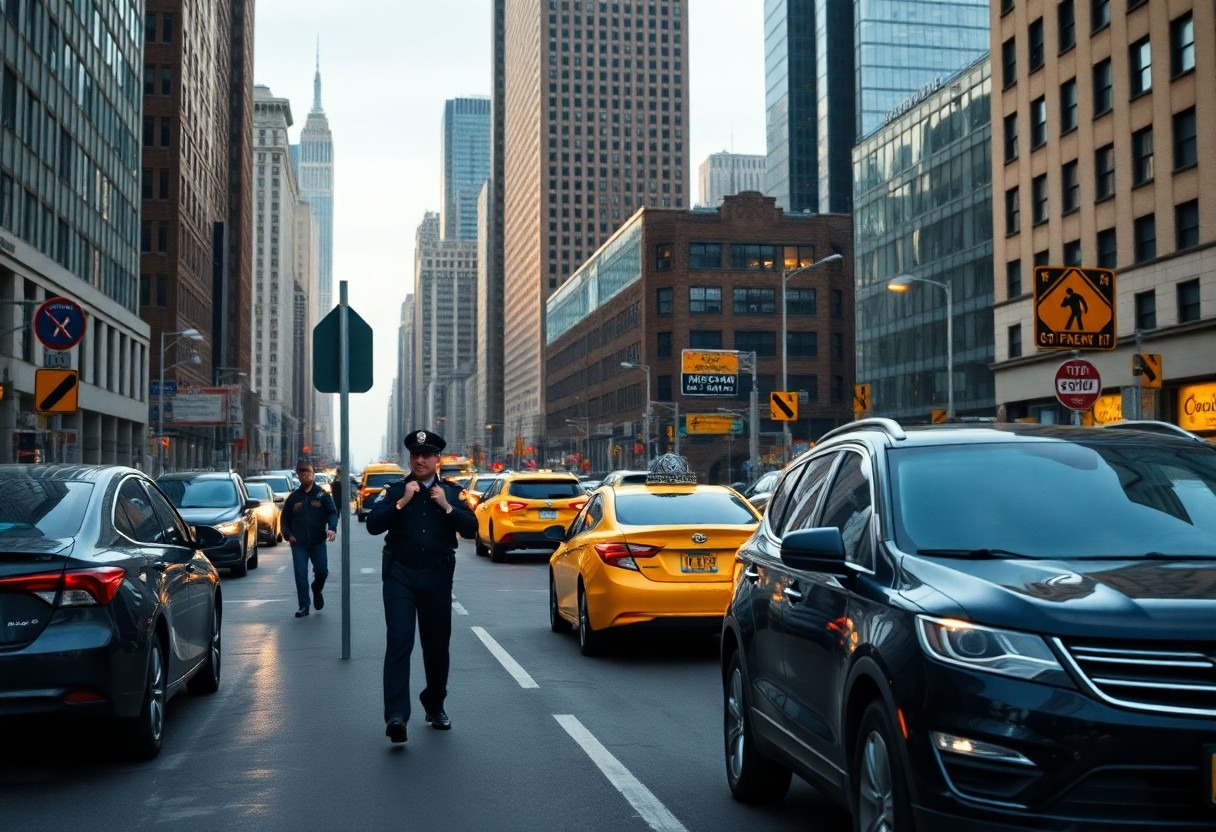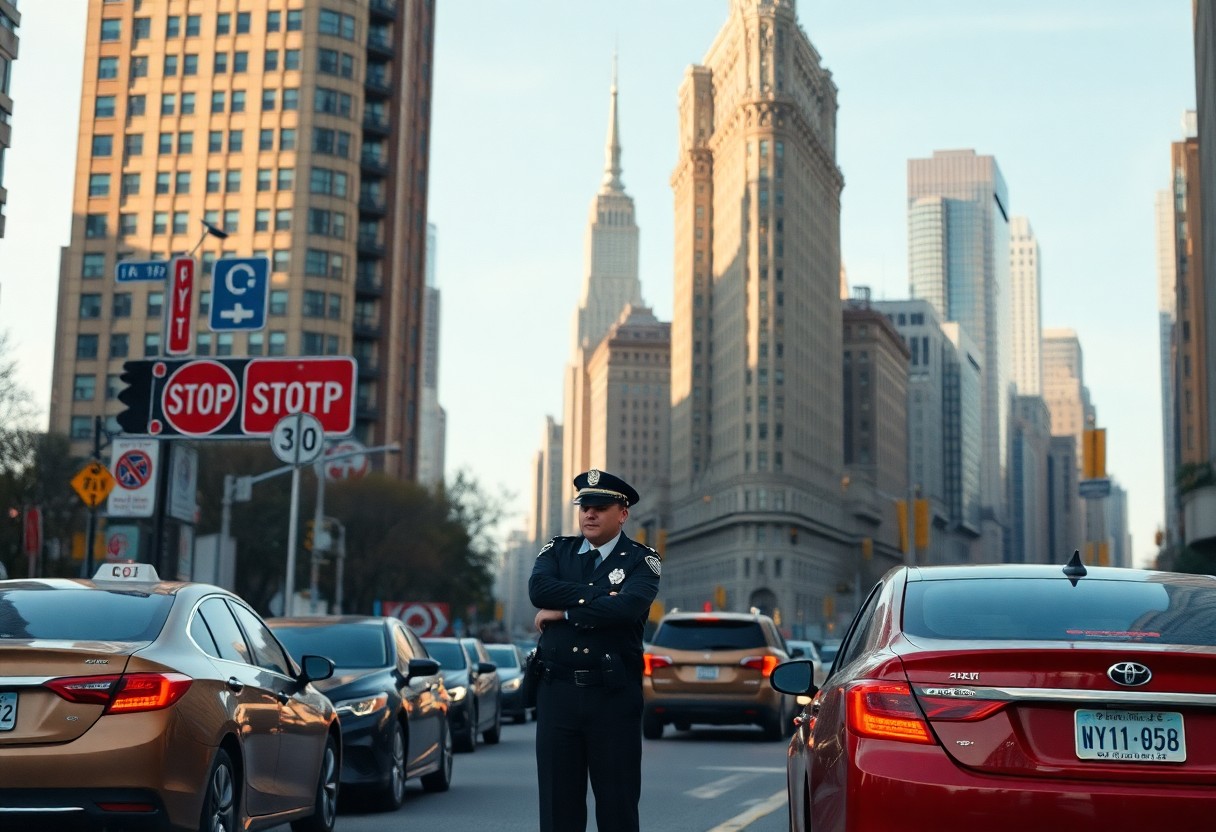To effectively navigate the bustling streets of New York, it’s crucial to grasp the unique challenges that come with driving in such a vibrant metropolis. Being behind the wheel in the Empire State means adapting to heavy traffic conditions while adhering to strict traffic regulations designed to protect all road users. Familiarizing yourself with specific local driving laws, such as the 25 mph speed limit in urban areas and the complete prohibition of handheld devices while driving, is essential. Whether you’re exploring Manhattan’s grid layout or journeying through the picturesque upstate regions, having a solid understanding of New York’s driving laws will empower you to navigate its diverse roadways confidently and stay safe on New York’s dynamic streets.
Essential Driving Regulations You Must Follow in New York
In New York, adhering to fundamental driving regulations is crucial for maintaining safety on the road. You must always drive on the right side of the road, ensuring you keep a safe distance from the vehicle ahead and utilize turn signals when changing lanes. Your vehicle should be equipped with functional headlights, taillights, and brake lights to ensure visibility and signal your intentions to other drivers. Remember, seat belts are mandatory for all passengers, and children under eight years old must be secured in appropriate restraint systems. These rules not only promote your safety but also enhance the overall driving experience by fostering a culture of responsibility and awareness on the road. By following these regulations, you contribute to a safer environment for everyone who shares the roadway.
Comprehending Speed Limits and Traffic Signal Compliance in New York
Speed limits in New York are not one-size-fits-all; they vary significantly based on location. The 25 mph speed limit is the default in New York City unless otherwise indicated by posted signs, while highways typically allow speeds ranging from 55 to 65 mph. It is vital to come to a complete stop at red lights and stop signs, as this is a key aspect of safe driving. In NYC, right turns on red are prohibited unless there is a specific sign permitting it. Additionally, intersections and school zones are actively monitored by traffic cameras to ensure compliance, which underscores the importance of being vigilant and adhering to all traffic signals. Understanding these regulations not only helps you avoid fines but also ensures that you are contributing to the safety of all road users.
Prioritizing Pedestrian Safety: Yielding and Right-of-Way Laws
In addition to standard traffic laws, it is imperative to always yield to pedestrians in crosswalks, regardless of whether they are marked or unmarked. This responsibility extends to stopping for school buses displaying flashing red lights and yielding to emergency vehicles. Failing to yield to pedestrians can result in hefty fines and points on your license, which can impact your driving record. Moreover, exercising extra caution in school zones and residential areas is essential due to the higher volume of pedestrian traffic. Remember, pedestrians have the right-of-way when crossing with the signal, and you must remain stopped until they have completely crossed the street. Blocking crosswalks or intersections, even temporarily, should be avoided to ensure the safety of all road users. By prioritizing pedestrian safety, you contribute to a more secure driving environment for everyone, especially in busy urban settings.
Additionally, it’s important to recognize that the responsibility for pedestrian safety falls on drivers, especially in areas with heavy foot traffic. This means being particularly attentive during peak hours when children are arriving or leaving school. Always look out for pedestrians who may unexpectedly enter the roadway, and be prepared to stop. By prioritizing pedestrian safety, you contribute to a more secure driving environment for everyone.
Ensuring Your Vehicle Meets Condition and Compliance Requirements
Before venturing onto New York’s bustling streets, your vehicle must meet specific state requirements to ensure safety and compliance. Regular maintenance is essential, including ensuring that your car has functional headlights, properly inflated tires, and well-maintained brakes. The New York Department of Motor Vehicles (DMV) mandates annual safety inspections for all registered vehicles to verify that they meet safety standards, which is crucial for the well-being of all drivers and passengers on the road. Staying on top of these requirements not only helps you avoid penalties but also enhances your vehicle’s performance and reliability. By keeping your vehicle in top condition, you are not only safeguarding your own safety but also contributing to the overall safety of New York’s roads.

Understanding Your Vehicle Registration and Insurance Obligations
Every legal vehicle operating in New York must have the proper documentation, which includes maintaining minimum liability insurance coverage of $25,000/$50,000 for bodily injury and $10,000 for property damage. Keeping your vehicle registration current is also essential, and you must display valid inspection stickers on your windshield as proof of compliance. Failure to meet these requirements can lead to hefty fines and even license suspension, which can complicate your ability to drive legally. By ensuring that all documentation is in order, you safeguard yourself against potential legal issues and ensure a smoother driving experience. Remember that staying informed about these obligations can significantly enhance your peace of mind while driving in New York.
Meeting New York’s Safety Equipment Standards for Legal Operation
In addition to registration, ensuring your vehicle meets New York’s safety equipment standards is crucial for legal operation. Your vehicle must be equipped with functioning headlights, brake lights, turn signals, and windshield wipers to enhance visibility and communication with other drivers. The state also mandates that vehicles have functional seat belts, mirrors, and a horn. These safety measures are vital for protecting your safety and that of others on the road. Furthermore, New York’s equipment regulations extend beyond basic requirements, including maintaining proper emission standards and undergoing regular smog checks to reduce environmental impact. Regularly checking these components will help ensure that your vehicle is safe and compliant. By prioritizing vehicle safety, you not only comply with state laws but also play a vital role in promoting road safety.
Moreover, it is important to regularly inspect your vehicle for adequate tire tread depth, proper functioning brakes, and working defrosters to prepare for varying weather conditions. Additionally, having emergency equipment such as hazard lights and reflectors readily available is essential for unexpected situations. By adhering to these safety equipment standards, you not only comply with the law but also contribute to a safer driving environment for everyone on the road.

Mastering Navigation in Special Zones and Local Restrictions
When driving in New York, you must exercise extra caution and comply with specific local regulations in designated zones. Certain areas, such as school zones, construction zones, and residential neighborhoods, have their own set of rules that must be strictly followed. Violating regulations in these areas can lead to significant fines, ranging from $90 to $600, depending on the severity of the infraction. Understanding and respecting these local rules is crucial for ensuring the safety of all road users and maintaining a harmonious driving environment. Awareness of these special zones can help you navigate more effectively and avoid costly penalties.
Maintaining Attention in School and Work Zones to Ensure Safety
School and work zones are among the most critical areas requiring your attention while driving. In these zones, you must reduce your speed to 15-20 mph during school hours, ensuring the safety of vulnerable pedestrians, especially children. In work zones, adhering to posted speed limits and maintaining a safe distance from construction workers is essential. Fines for speeding in these areas are often doubled, emphasizing the importance of heightened safety awareness. By staying vigilant and adhering to the rules in these zones, you play a crucial role in protecting those who are most at risk. Always be aware of your surroundings and ready to respond to any situation that may arise.
Essential Parking Regulations to Avoid Costly Fines
Understanding the vital parking rules in New York is essential to avoid unnecessary fines and inconveniences. Alternate-side parking regulations are enforced in most areas, and you must carefully observe posted signs indicating specific days and times for parking restrictions. Metered parking zones are prevalent throughout the city, with rates varying by location and time of day, so it’s important to always check the meter. Additionally, you must abide by strict enforcement of fire hydrant clearance (a minimum of 15 feet) and avoid no-standing zones near intersections. By being proactive about parking regulations, you can save yourself from potential fines and ensure that your vehicle is parked legally.
Moreover, being aware of residential permit requirements in certain neighborhoods is critical to prevent parking violations. Failure to comply with these regulations can result in tickets ranging from $65 to $115, and your vehicle may be towed if you block essential services or create safety hazards. Staying informed and compliant with parking regulations will save you from costly fines and ensure a smoother experience while driving in New York.
Understanding the Requirements for Obtaining a Driver’s License in New York
Having a valid driver’s license is essential for legal driving in New York. To operate a vehicle, you must be at least 16 years old and possess either a New York State driver’s license or a valid out-of-state license. If you are a first-time driver, completing a state-approved driver education course and passing both written and road tests is mandatory. These requirements are designed to ensure that all drivers are adequately prepared to navigate New York’s complex roadways. By understanding these requirements, you can ensure that you are legally qualified to drive in the state.
Exploring the Various Classifications of New York Driver’s Licenses
One of the most critical aspects of driving in New York is understanding the various license classifications. Class D is the standard license for passenger vehicles, while commercial driver’s licenses (CDL) range from Class A to C, each with specific privileges and restrictions regarding the types of vehicles you can operate legally. Knowing the differences in license classes is vital to ensure you have the proper credentials for the vehicle you intend to drive, thus avoiding legal issues and contributing to road safety. By being informed about these classifications, you can better navigate the requirements necessary for your driving needs.
Guidelines for Out-of-State License Holders Moving to New York
If you hold an out-of-state license, it remains valid for up to 30 days after establishing residency in New York. As a tourist or temporary resident, you can legally drive with your home state’s license. International visitors must possess a valid foreign license along with an International Driving Permit to drive legally in New York. Furthermore, specific rules apply to military personnel and their families, allowing them to maintain their home-state licenses while stationed in New York. If you become a permanent resident, you must exchange your out-of-state license within 30 days by visiting a DMV office and passing a written test to ensure compliance with state regulations. Understanding these guidelines can help you transition smoothly into driving legally in New York.
Implementing Effective Safety Measures While Driving in New York
For your safety on New York roads, adhering to strict traffic regulations and maintaining constant awareness of your surroundings is paramount. Your vehicle should be equipped with essential safety features, including functional headlights, taillights, turn signals, and properly inflated tires. Regular vehicle maintenance is crucial for safe driving, especially in New York’s demanding traffic conditions. By prioritizing these safety measures, you can significantly reduce the risk of accidents and ensure a safer driving experience. Staying proactive about vehicle maintenance and safety practices not only protects you but also helps ensure the safety of others on the road.
Child Safety Regulations to Protect Our Youngest Passengers
To safeguard young passengers, any child under eight years old must be secured in an appropriate child restraint system. Children under two years of age are required to ride in a rear-facing car seat, while those between the ages of two and four must use a forward-facing car seat. For children aged four to eight, booster seats are necessary. Violations of these requirements can result in fines of up to $100 and three penalty points on your license. By enforcing these child safety measures, you contribute to the protection of our youngest and most vulnerable passengers on the road. It’s essential to educate caregivers about these regulations to ensure compliance and enhance child safety.
Ensuring Seatbelt Compliance and Understanding Mobile Device Usage Rules
To enhance safety for you and your passengers, mandatory seatbelt use for all vehicle occupants is enforced in New York. It is essential to ensure that everyone in the vehicle is buckled up, regardless of their seating position. The use of handheld devices while driving is strictly prohibited, with fines ranging from $50 to $450 for violations, depending on whether it is a repeat offense. Remember, even a momentary distraction can lead to severe consequences on New York roads. Your first violation of mobile device laws results in five driver violation points, and subsequent offenses may lead to license suspension. Although hands-free devices are permitted, it’s advisable to minimize their use to maintain focused attention on the road. By adhering to these regulations, you not only protect yourself but also contribute to the overall safety of the driving environment in New York.

Awareness of Traffic Violations and Their Consequences for Drivers
Navigating New York’s traffic laws necessitates your constant vigilance and attention to detail. The city enforces strict compliance with traffic regulations, with violations leading to severe consequences. Understanding these rules is not solely about avoiding fines; it’s also critical for maintaining road safety for everyone involved. Being aware of potential infractions can significantly reduce your risk of accidents and legal issues. By educating yourself about common violations, you can navigate the streets more confidently and responsibly.
Identifying Common Traffic Infractions to Avoid Unnecessary Penalties
On New York streets, some of the most common violations include speeding (especially in school zones), running red lights, using mobile phones illegally, and making improper turns. The likelihood of enforcement is high, as the city employs both traditional police patrols and automated enforcement systems to monitor compliance. Recent statistics indicate that speed cameras alone issued over 4 million violations in 2022, highlighting the importance of adhering to speed limits and traffic signals to avoid penalties. By being proactive and aware of these common infractions, you can contribute to a more orderly and secure traffic environment.
Understanding Penalties, Fines, and Their Long-Term Implications
When it comes to penalties for traffic violations, first-time offenders may face fines ranging from $50 to $1,000, depending on the nature of the offense. The New York DMV operates on a point system, where accumulating 11 points within 18 months can lead to license suspension. Additionally, your insurance rates may significantly increase following any violations, impacting your financial standing. It’s important to recognize that New York employs a graduated penalty system, meaning that repeat offenses result in progressively severe consequences. Violations can remain on your driving record for up to four years, potentially affecting your insurance rates and driving privileges. The state’s zero-tolerance policy for DUI offenses can lead to immediate license suspension and mandatory court appearances, underscoring the need for responsible driving. By understanding these penalties, you can make informed choices while driving.
Final Thoughts: Ensuring Safe Driving Practices in New York
Driving in New York necessitates your full attention and adherence to a variety of specific regulations. Your safety, as well as that of others, relies on following speed limits, yielding to pedestrians, and ensuring proper child restraints. You can find well-maintained vehicles that meet all safety requirements through RentaCar24.org, allowing you to navigate the city with confidence. By staying informed about local traffic laws and keeping these essential guidelines in mind, you’ll be well-equipped to handle the challenges of New York’s busy streets. Understanding and respecting these regulations will contribute to a smoother and safer driving experience throughout the Empire State.
The Article: Driving in New York: Essential Rules and Regulations for Safe Travel appeared first on https://rentacar24.org/
The Article Essential Rules and Regulations for Safe Driving in New York Was Found On https://limitsofstrategy.com



Navigating New York’s streets certainly demands a unique skill set. I’ve found that the city’s grid system, while daunting at times, actually has its advantages, especially for those who take the time to learn the quickest routes. However, beyond just understanding the layout, the emphasis on driving laws cannot be overstated. For instance, the ban on handheld devices is not just a regulation; it’s a crucial safety measure. In a city teeming with pedestrians, cyclists, and other drivers, even a moment of distraction can lead to dire consequences.
You make a great point about New York’s grid system. It can definitely feel overwhelming at first, especially when you’re trying to navigate the chaos of the city’s streets, but once you start to get a sense of the layout, it feels like you’ve unlocked a new level of urban exploration. I remember when I first started driving in the city; I often underestimated how important it was to really familiarize myself with the quick cuts and shortcuts. Sometimes those little-known side streets can save you a lot of time, especially during rush hour.
You’ve captured that learning curve perfectly. The intensity of New York can be daunting, especially driving amidst all that energy. I remember feeling the same rush when I first started getting familiar with the streets. It’s amazing how those seemingly hidden side streets transform your understanding of the city.
You make a great point about the grid system in NYC. Once you get the hang of it, those avenues and streets can feel like an intricate puzzle, each piece having its place. I remember when I first started driving there—I found the experience both exhilarating and stressful. Knowing the quickest routes is definitely an advantage, especially with how fast-paced the city can be.
I completely relate to that feeling of exhilaration mixed with stress when driving in NYC. It’s almost like a rite of passage—each trip becoming a mini-adventure. The grid can definitely feel like an intricate puzzle, but I think it’s fascinating how it reflects the city’s history and planning. I still find myself discovering little corners that I hadn’t seen before, which keeps it interesting.
You’re so right about that intricacy to the grid. It really does feel like an elaborate puzzle once you get used to it, but I remember my first time navigating through the streets as well. There’s something almost poetic about the chaos of it all, right? The mix of pedestrians, cyclists, and cars can be overwhelming at first.
I completely get what you mean about the grid system feeling like a puzzle. Once you start to understand it, navigating becomes almost second nature, but those first few drives can definitely be a whirlwind. I remember my first experiences driving in the city, too. It felt like a mix of adrenaline and anxiety—like every turn came with its own storyline.
This post highlights some crucial points about driving in New York, but it touches on the surface of a much broader issue: the interaction between urban infrastructure and driver behavior. While it’s true that heavy traffic and strict regulations create unique challenges, they also bring to light the importance of educating drivers about the realities of urban living.
Your insights on navigating New York’s streets hit home for me, especially as someone who’s spent quite a bit of time driving through the city. The challenges posed by heavy traffic and the hustle of city life can be quite daunting, but they also offer a unique sort of thrill. I remember my first experience driving in Manhattan; it was a whirlwind of colors and sounds, and I quickly learned that keeping my cool and being aware of my surroundings was essential. The stark contrast of the urban grid of Manhattan compared to the scenic drives upstate is striking—you really get to experience two extremes of driving culture within the same state.
You really captured the essence of driving in New York City. It’s fascinating how quickly the atmosphere shifts from the vibrant chaos of Manhattan to the serene landscapes upstate. I think your experience highlights a key aspect of city driving: it demands a certain level of adaptability. One moment you’re queuing up at a light surrounded by the honks and rush of taxis, and the next you’re cruising along a quiet, tree-lined road, taking in the greenery.
You raise some valid points about the unique challenges of driving in New York, especially regarding local laws like the 25 mph speed limit and the handheld device ban. However, I’m curious about how these regulations are enforced, particularly in areas with heavy pedestrian traffic. I’ve noticed that while the laws are clear, compliance can be lax—especially in bustling neighborhoods where delivery drivers and rideshares often seem to ignore speed limits for the sake of efficiency.
You’re touching on a real nerve in the conversation about urban driving. The tension between maintaining safety and the pressure to deliver quickly is something many of us observe daily. In those busy neighborhoods, it can feel like a dance between pedestrians and vehicles, and sometimes it seems like the rhythm is completely off.
You’re touching on a real nerve in the conversation about urban driving. It really does feel like a delicate dance sometimes, doesn’t it? I’ve noticed that in many busy neighborhoods, it can become a frustrating balancing act—a driver’s urgency clashing with pedestrians who just want to cross safely.
You’ve touched on a significant concern that many New Yorkers and visitors face daily. The enforcement of these regulations, particularly in busy areas, does seem inconsistent. Heavy pedestrian traffic in neighborhoods like Times Square or the Lower East Side creates a chaotic backdrop that can make it difficult for enforcement officers to monitor every infraction.
You bring up a crucial point about enforcement of driving regulations in busy areas. When we think about New York City, it’s clear that the density of the population and the volume of traffic create a perfect storm for challenges with compliance. The laws are there for a reason—to protect pedestrians and cyclists in particularly busy neighborhoods—but the reality is that obeying these rules can sometimes take a backseat to the hustle and bustle of daily life, particularly for drivers trying to make a living.
Navigating the streets of New York truly requires a combination of agility, awareness, and respect for the regulations in place. Your emphasis on understanding local driving laws resonates with anyone who has experienced the unique rhythm of the city. I’ve driven in New York several times, and I often find that familiarity with the area can only take you so far. Each neighborhood has its own character and challenges; for example, the bustling Nature of Times Square compared to the quieter, yet still complex, layout of Brooklyn.
Navigating the streets of New York can indeed feel like an adventure with every drive. I’ve found that the key is staying present and aware of the hustle around you, especially with pedestrians and cyclists often sharing the road. The emphasis on the 25 mph speed limit really highlights the city’s priority on safety—especially in crowded areas. Plus, with the rise of rideshare apps and electric scooters, it’s interesting to see how city dynamics are evolving. It makes me wonder how technology could further enhance the driving experience, potentially reducing traffic through smart routing or integrated public transit systems. I’d love to hear if anyone has had memorable experiences or tips while driving in NYC that made navigating easier or safer!
I appreciate your perspective on navigating New York. Staying present is so crucial, considering the vibrant mix of pedestrians, cyclists, and other drivers. It’s like the city has its own rhythm, and finding your place in it requires a certain awareness.
You’ve really captured the essence of driving in New York. It’s true—the streets are a tapestry of energy, where every turn can lead to a new experience. Staying present is crucial, especially with the ebb and flow of pedestrians and cyclists. It’s a real dance out there, isn’t it? Your mention of the 25 mph speed limit resonates with the city’s commitment to safety. It serves as a reminder that behind every car, there are lives at stake, and slowing down can make a difference.
Navigating the streets of New York is definitely like stepping into a vibrant tapestry of life—each block has its own rhythm. Staying present and aware really is essential; the ebb and flow of pedestrians and cyclists can be surprising, especially when you least expect it. That 25 mph speed limit plays a crucial role, not just as a guideline but as a reminder of the shared space we all inhabit in this bustling city. Keeping those speeds down helps protect everyone, from the hurried office worker to the leisurely tourist.
Navigating New York’s streets can indeed feel like a high-stakes game, where understanding the driving regulations is just the beginning. Having lived in the city for a few years, I’ve realized that it’s not only about knowing the laws—it’s also about the rhythm of the streets. For instance, adapting to the ebb and flow of traffic around rush hour is almost an art form in itself. I found that anticipating the sudden stops, cyclists weaving through traffic, or pedestrians darting across streets adds a layer of complexity that demands heightened awareness.